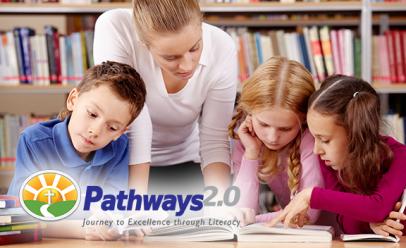 By: Kendall Hunt RPD with contributions from the writing team of Pathways2.0 Reading and Language Arts
By: Kendall Hunt RPD with contributions from the writing team of Pathways2.0 Reading and Language Arts
The Pathways2.0 curriculum emphasizes independent student learning.
It utilizes many educational tools that encourage small-group work. For example, reading workshops are used for whole-group and small-group instruction, along with independent reading. Another tool, “Think-Pair-Share,” urges students to first think about a question, then share it with a partner, and then bring it back to the whole group. “Buddy Reading” is a similar strategy in which students read in pairs. Lastly, student-led groups follow the principle of “You do, I help,” meaning that students learn from one another without the instructor present.
However, what do these small groups do for your students’ classroom experience?
-Small groups give every kind of student a platform to speak.
Every classroom has introverts and extroverts. Although still engaged, shy students are less likely to participate in large-group activities. Small groups give quieter students a chance to speak up and be heard and encourage reluctant students to participate.
-You can observe where students need extra help.
By listening to the students in their small groups, you can pinpoint exactly what they are struggling with. If one small group is struggling with a concept, chances are the rest of the class is too. It is also easier to answer one-on-one questions that don’t require the attention of the full class.
-Students can learn from one another.
Students learn best from one another. Sometimes, a peer can help another by explaining a concept in a new light. Also, by observing one another, students can come to know the best ways in which they learn. Whereas one might learn best by reading out loud, another might learn better by reading quietly.
-Small groups further develop their collaboration, communication, and listening skills.
A small-group environment forces students to work with one another and thus strengthens their ability to collaborate, communicate, and listen. All of these skills are very important in the workplace and in higher education classrooms.
-Students can discover different perspectives.
Each student thinks differently. In small groups, students see from the different perspectives of their peers. Especially when studying literature, there is often more than one way to understand a concept. Small groups are a great way to introduce students to new perspectives and ways of thinking.
-Small groups encourage independent learning.
It is very important for early students to grasp the concept of independent learning. Students in higher education rely on independent learning because they are no longer spoon-fed information from a teacher. It is crucial to prepare students for this environment early.
-Small groups provide students with individualized feedback.
Small groups allow students to gain personal feedback from their peers and teachers. By interacting in their small groups, students can compare their learning with each other. Students can see where they stand among the rest. Also, as the teacher, you have the ability to give personal feedback to students one-on-one, allowing you to steer their learning in the right direction.
-Small groups spark confidence in students’ own ideas and sharing.
In small groups, students learn to voice their opinions and stand up for their own ideas. In return, students gain confidence in themselves and their own knowledge. They will be more willing to participate in the larger group once they have more confidence in speaking out in the classroom.
-Small groups prepare students for future higher education or career environments.
Collaboration is a critical skill used in the work environment and in higher education classrooms. Small-group work trains students to collaborate effectively with their peers, just like any real work environment. Also, higher education classes require students to cooperate with one another, which is an essential feature of small-group work.
-You are able to bring it back to the large group.
Transitioning from small groups to the large group is natural and easy. You have the power to pull ideas from each small group back to the main idea at large. You can also engage the students by answering questions that you heard groups struggling with.
Clearly, small-group work has many benefits. It strengthens skills crucial for students’ futures, gives students confidence, and is a successful tool for teachers at all grade levels. It also offers students a glimpse into a future of lifelong collaboration and community development in both further education and in life. Small-group work gives every student an opportunity to interact with the real world. Pathways2.0 emphasizes small-group work because of its exemplary effects on students’ experience in the classroom.